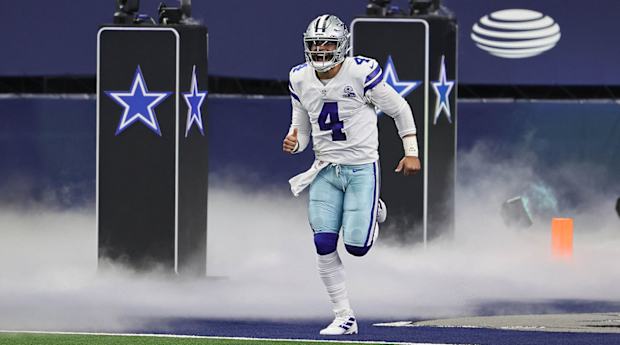Much has been made of Dak Prescott's contract situation, before and after his injury in Week 5, but he will likely end up in the same position next February he'd be in anyway.
In the aftermath of
Dak Prescott’s bone-chilling injury and reaction on Sunday, many have asked me about his business decision to turn down a multi-year offer from the Cowboys to instead play on a one-year contract with no security beyond it. Here are some thoughts.We do not know what the Cowboys were offering, but we do know from their contract history that they prefer long deals—the longer the better—with guarantees only in the low-risk early years of the deal. They have previously signed star players to contracts with lengths up to 10 years, which are essentially one- or two-year contracts with team options following that. Amid that landscape, the Chiefs and Patrick Mahomes agreed to a 12-year deal, one that only secures $63 million over the next three years (Ryan Tannehill is making $91 million over the same time frame). Wanting both a better deal from the Cowboys and more optionality in his career, Prescott chose to play in 2020 on the one-year franchise tag number of $31 million.
Yes, if Prescott were never to play again or to find himself in a non-leveraged position next March and taking a below-market “prove it” contract, he would have been better off taking whatever the Cowboys offered last year, giving him more than the $31 million guarantee that he has. But ask yourself: Is that really the most likely scenario here? It is not.
Much more likely is that this upcoming February we will be in the same place we were last February: with Prescott a pending free agent and the Cowboys having to 1) negotiate a long-term contract; 2) re-apply the franchise tag, or 3) set him free into a marketplace desperate for young and proven quarterbacks. And my sense is that, as long as his recovery and rehabilitation has gone well, Prescott will again be in a position to leverage, at the least, a franchise tag of around $38 million for the 2021 season.
Many players have returned from serious injuries in their contract years to earn top-of-market contracts in free agency. Allen Robinson (Bears) and Earl Thomas (Ravens) come immediately to mind. To think that Dak Prescott will now suffer in career earnings because of an early-season injury at age 25 is, well, knee-jerk.

The real business of football issue here is the franchise tag, a powerful management tool that is weaponized for situations just like this. Last year Prescott was the most underpaid player in the league, as a starting quarterback making $700,000. This year he finally made it to the promised land in sports business, free agency, only to be restricted to negotiating only with the. And the Cowboys used the leverage of the tag to not only take Prescott off of the market, but to be firm in negotiations, knowing they had his contract rights no matter what outcome.
Were there no NFL franchise tag, Prescott would have a long-term deal, and it would be the most player-friendly contract in NFL history. But his free agency was only a mirage. The tag is a massive advantage for management over their most important labor. Imagine the NBA with a franchise tag…
While his injury was gruesome and takes him off the field in 2020, I am still bullish on Prescott’s long-term earnings and still believe he has played the situation correctly. Time will tell, but to think Prescott will be limited to anything below elite quarterback earnings in the future is, in my opinion, narrow thinking.
The NFL is playing through
I have been vocal here, questioning the NFL as it powers through amid a pandemic. My pondering of “Are we really doing this?” has drawn rebukes, including ones that I was rooting against football. Please. My point was, and is, that no matter how many protocols are put in place and off-field social distancing is practiced, the game of football requires intimate contact in its preparation, practice and play. It was naive to think there would not be hiccups and even outbreaks. And now we have had a few, including a team outbreak (the Titans) and a star player infected (Cam Newton). My surprise was not at the infections, but at the fact that this hadn’t happened before Week 4. And we would be naive to think this won’t happen throughout the season.
The NFL and the NFLPA have done and are doing extraordinary work job of playing through this pandemic, but positive tests for COVID-19 among players and staff in a non-bubbled environment are inevitable. There is obvious risk in playing; the challenge is mitigating and managing the risk.
The NFL was fortunate to be able to solve the postponements of Titans–Bills and Patriots–Broncos with minimal disruption, but the margins of “reworking” the schedule will only get tighter; we will soon be in “pushing the season back” mode. Of course, the NFL is going to do everything possible not to shut down a $15 billion business. I get it. But in doing so, let’s all recognize there will be disruptions.
Commissioner Goodell’s stern letter to the 32 teams after the Titans’ outbreak, threatening discipline up to and including forfeiture of games and/or draft picks, read like the letters I see from college presidents. I am a professor at Villanova and my son is a freshman in college. The message from all these letters: Adhere to the established protocols or you will face serious consequences.
Some have suggested bubbling each NFL team in hotels in their home city, and I have discussed eight bubbles, by division. We are not there yet, but my sense is that the NFL has to have such contingency plans but not implement them unless it absolutely, positively has to.
We do need to accept that one of the most important concepts in the NFL—competitive balance —will not be as important 2020. Some teams have had fans and some have not; some teams have prepared for games virtually instead of with on-field practices; multiple teams have already faced schedule disruptions. And the Titans will play Tuesday night after one day of practice in the last three weeks. But in the larger scheme of things is: So what? Competitive balance will be sacrificed in the name of playing through a pandemic: deal with it.
Bill O'Brien was destined to fail
There were some gaffes in Bill O’Brien’s tenure as general manager of the Texans, including:
• Acquiring Laremy Tunsil—for two first-round draft picks—without securing a simultaneous contract extension, which gave Tunsil extraordinary leverage that he later used.
• Trading one elite player, DeAndre Hopkins, for inferior return value.
• Trading another elite player, Jadaveon Clowney, for inferior return value and paying him $7 million to go away.
O’Brien’s ineptitude as a general manager, however, was not a surprise. The coach-as-general-manager model is an untenable one; he was put in a position to fail.
Coaches are present-focused; general managers are forward-focused. Coaches need to have their players’ backs; general managers need to be detached from their players. To combine the two roles with one person is a recipe for failure.
When I was with the Packers and general manager Ron Wolf retired, our head coach Mike Sherman took on general manager duties as well. Sherman would often come to me before talking to a player and say, “Andrew, I need to make you the bad guy here.” I understood. The head coach could not be “the bad guy” while trying to inspire and motivate players as their coach; I had to handle the business side. When Andy Reid was coach/general manager in Philadelphia, Joe Banner served adroitly as his bad guy. Unfortunately for Bill O’ Brien, he was his own bad guy and, in talking to agents of Texans players, he grated on people in that role.
O’Brien’s naivety in that role was no secret around the league, and other teams smelled blood in the water when dealing with the Texans. Going forward, the roles will be separated but there is detritus left behind, including the absence of a first-round pick—which may be a truly valuable one—in the 2021 draft.
Live and learn.

0 Comments:
Post a Comment